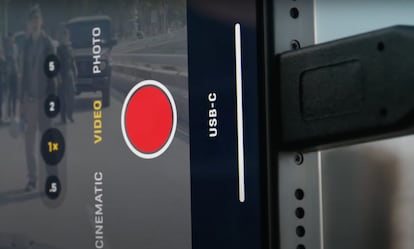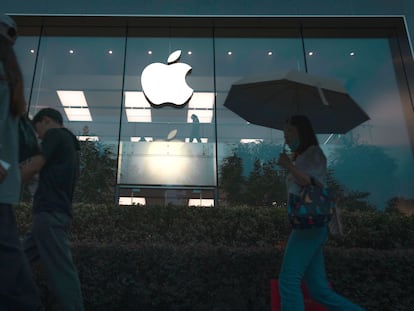Now that the iPhone has USB-C, will we be able to use the same charger with any phone?
Apple’s adoption of the universal charging connector has a strong impact on users, the environment and the technology sector

Apple has finally given in. With the new iPhone 15, the company jumped on the universal charging connector bandwagon, a measure that had to be taken sooner or later if they wanted to comply with the European regulations, as the European Parliament voted in October 2022 to make this port mandatory for all mobile phones and other devices as of December 28, 2024.
What did Apple gain by clinging to the Lightning port on iPhones?
The Lightning port debuted with the iPhone 5 in 2012. “Its main advantages, especially if we take into account the USB options of that time, were its compact, minimalist size, its durability and the fact that it is reversible [it did not have to be connected in a specific orientation],” says Fernando Suárez, president of the General Council of Official Colleges of Computer Engineering in Spain.
Although the company began the transition to USB-C for its computers in 2015 and for its iPads in 2018, it was reluctant to include it in the iPhone. “Obviously we’ll have to comply, we have no choice,” stated Greg Joswiak, Apple’s senior vice president of worldwide marketing, in an interview published in October 2022 in The Wall Street Journal.
Kewin Charron, senior manager of refurbishing operations at Back Market, explains that Apple has stuck to the Lightning port all these years in order to keep both the manufacturers of accessories and the consumers within its ecosystem. “Apple set itself apart from the phones from other brands by keeping this port,” emphasizes Francisca Pérez, director of the computer engineering degree at the San Jorge University (Spain). The expert, who is also a teacher of the master’s degree in advanced software technologies for mobile devices, explains that this port was a good source of income for Apple, thanks to the sale of cables and other compatible accessories.
Will we be able to charge the new iPhone with the same cable that Android phones use?
“In theory, compatibility should be total, as long as it’s a modern charger with enough power for it,” says Suárez. The loading speed may vary from one to another. Charron explains that fast charging may be limited, depending on the standard used by the manufacturer, and advises using a cable and charger with Power Delivery certification to get fast charging and avoid problems; a non-certified cable or charger can cause slow or inadequate charging, damage the battery or even burn the device’s circuits. To protect users from harmful chargers and hacking attacks through the new connector, the USB-IF consortium implemented its own certification in 2019.
Can we also charge our tablets and computers with the phone’s USB-C cable and charger?
At the presentation of the iPhone 15, Apple assured that the same cable will be able to charge a Mac, an iPad, an iPhone and even the second generation AirPods Pro, which have also been updated and have a charging case with a USB-C port. However, Charron recommends paying attention to the charger’s power, because tablets and laptops require more powerful chargers.
He explains that a user can charge their phone with a laptop’s USB-C charger, but they cannot charge their computer with a phone charger (or it may charge, but very slowly). Francisca Pérez advises to always check the power of the charger: “To charge the phone or tablet, a 20 to 35-watt charger would be adequate. However, for a laptop, a charger of more than 70 watts would be preferable, with which the battery can be charged faster and which, in addition, supports the energy consumption of the computer while it is being used.”

How long until the universal charging system becomes a reality?
Pérez explains that a transition period is taking place, in which some charging points have the old USB port (type A) and others the new one (type C). “If you just carry the new USB-C cable, you may not be able to charge your phone on an older plane.” Furthermore, when connecting the phone to a USB port in airports, subway stations, buses, libraries, hotels or cafes, one must be extremely cautious: “A USB can also transmit data (not just electricity), and that is sometimes used to spread malware or steal information,” points out Suárez.
What happens now with the old Lightning cables and accessories?
When Apple launched the Lightning port in 2012, it rendered millions of cables and accessories that used the previous connector obsolete. Something similar could now happen to those who purchase an iPhone 15. To deal with this problem, Apple also launched a USB-C to Lightning adapter, which can be used with any iPhone or iPad that comes with the universal port. A reverse adapter will also be necessary to use a universal charger with the phones, keyboards and mice that still have a Lightning port.
How will this impact the environment?
When Apple refused to let go of the Lightning port, it argued that this regulation would force its customers to change cables, which would generate a great amount of electronic waste. Mário Barros, assistant professor at the Department of Architecture, Design and Media Technology at Aalborg University (Denmark), explains that this argument “can be countered with the advantages of having a universal standard that many Apple users could already be using.”
For Daniel Guzzo, a postdoctoral researcher at the Technical University of Denmark who has studied the sustainability impacts of the circular economy action plan of the European Commission, a market leader such as Apple taking this measure is a very relevant thing. “That the same charger can be used on all devices means that each user needs fewer chargers.” The expert states that the fact that some cables will be discarded “should not overshadow the possible positive impacts of the common charger initiative,” and insists that most homes already have a USB-C charger.

How does the change affect data transfer?
Before the iPhone presentation, John Gruber, a renowned analyst of Apple products, pointed out that beyond the convenience of sharing a connector with any other latest generation mobile phone, USB-C will also be a great advantage for those who use the phone as an ultra high definition video camera. The reason is that the universal connector allows for a much higher transfer speed than the Lightning when the user wants to transfer files via cable from the phone to a computer (for instance, for video post-production) or use the iPhone 15 Pro to record 4K video directly to an external hard drive. Completing the transition to USB-C was essential to offer these features to iPhone users.
Sign up for our weekly newsletter to get more English-language news coverage from EL PAÍS USA Edition
Tu suscripción se está usando en otro dispositivo
¿Quieres añadir otro usuario a tu suscripción?
Si continúas leyendo en este dispositivo, no se podrá leer en el otro.
FlechaTu suscripción se está usando en otro dispositivo y solo puedes acceder a EL PAÍS desde un dispositivo a la vez.
Si quieres compartir tu cuenta, cambia tu suscripción a la modalidad Premium, así podrás añadir otro usuario. Cada uno accederá con su propia cuenta de email, lo que os permitirá personalizar vuestra experiencia en EL PAÍS.
¿Tienes una suscripción de empresa? Accede aquí para contratar más cuentas.
En el caso de no saber quién está usando tu cuenta, te recomendamos cambiar tu contraseña aquí.
Si decides continuar compartiendo tu cuenta, este mensaje se mostrará en tu dispositivo y en el de la otra persona que está usando tu cuenta de forma indefinida, afectando a tu experiencia de lectura. Puedes consultar aquí los términos y condiciones de la suscripción digital.
More information
Archived In
Últimas noticias
NASA discovers Titan doesn’t have an ocean, but a ‘slushy ice layer’ that increases possibility of life
Innocence lost in the forest of the child soldiers: ‘Each leader of the armed group had his girls’
‘Fallout’ or how the world’s largest company turned an anti-capitalist apocalyptic Western into a phenomenon
From inflation to defending migrants: Eileen Higgins and Zohran Mamdani inaugurate the new Democratic resistance against Trump
Most viewed
- ‘El Limones’ and the growing union disguise of Mexican organized crime
- Christian Louboutin: ‘Young people don’t want to be like their parents. And if their parents wear sneakers, they’re going to look for something else’
- The low-cost creative revolution: How technology is making art accessible to everyone
- ‘We are dying’: Cuba sinks into a health crisis amid medicine shortages and misdiagnosis
- A mountaineer, accused of manslaughter for the death of his partner during a climb: He silenced his phone and refused a helicopter rescue











































